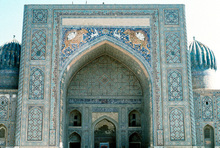| dc.coverage.spatial | Site: Samarkand (Uzbekistan) | en_US |
| dc.creator | Unknown | en_US |
| dc.date.accessioned | 2010-06-02T19:45:29Z | |
| dc.date.available | 2010-06-02T19:45:29Z | |
| dc.identifier | 143901 | en_US |
| dc.identifier.uri | http://hdl.handle.net/1721.3/53214 | en_US |
| dc.description | The Shir Dar or Sher Dor madrasa was built in the seventeenth century, as a teaching institution and residential school of Islamic sciences. It forms the famed Registan Square ensemble in Samarkand, with the earlier constructed Ulugh Beg madrasa (1417-1421) and later built Tilla Kari madrasa (1646-60). The structure marks a significant continuation of the four iwan, square plan, and Iranian madrasa typology. It reinforces the Timurid emphasis on scale, and resultantly on external facades.
Source: Archnet | en_US |
| dc.description | exterior, view of pishtaq, 1987 | en_US |
| dc.format.medium | brick | en_US |
| dc.relation.ispartof | 121166 | en_US |
| dc.rights | (c) Roya Marefat 1987 | en_US |
| dc.subject | Lions | en_US |
| dc.subject | Madrasahs | en_US |
| dc.subject | Islamic religious education | en_US |
| dc.subject | Islam -- History | en_US |
| dc.subject | Architecture, Islamic--Asia, Central | en_US |
| dc.subject | Religious architecture | en_US |
| dc.subject | Architecture, Islamic --Uzbekistan | en_US |
| dc.subject | Architecture--Asia, Central | en_US |
| dc.title | Shir Dar Madrasa | en_US |
| dc.title.alternative | Shirdar Madrasa | en_US |
| dc.title.alternative | Shirdor Madrasa | en_US |
| dc.title.alternative | Shir Dor Madrasa | en_US |
| dc.type | Image | en_US |
| dc.rights.access | All rights reserved | en_US |
| dc.identifier.vendorcode | A9 | en_US |
| vra.culturalContext | Central Asian | en_US |
| vra.culturalContext | Islamic | en_US |
| vra.culturalContext | Uzbek | en_US |
| vra.technique | construction | en_US |
| vra.worktype | Madrasa | en_US |
| dc.contributor.display | Islamic, Central Asian | en_US |


